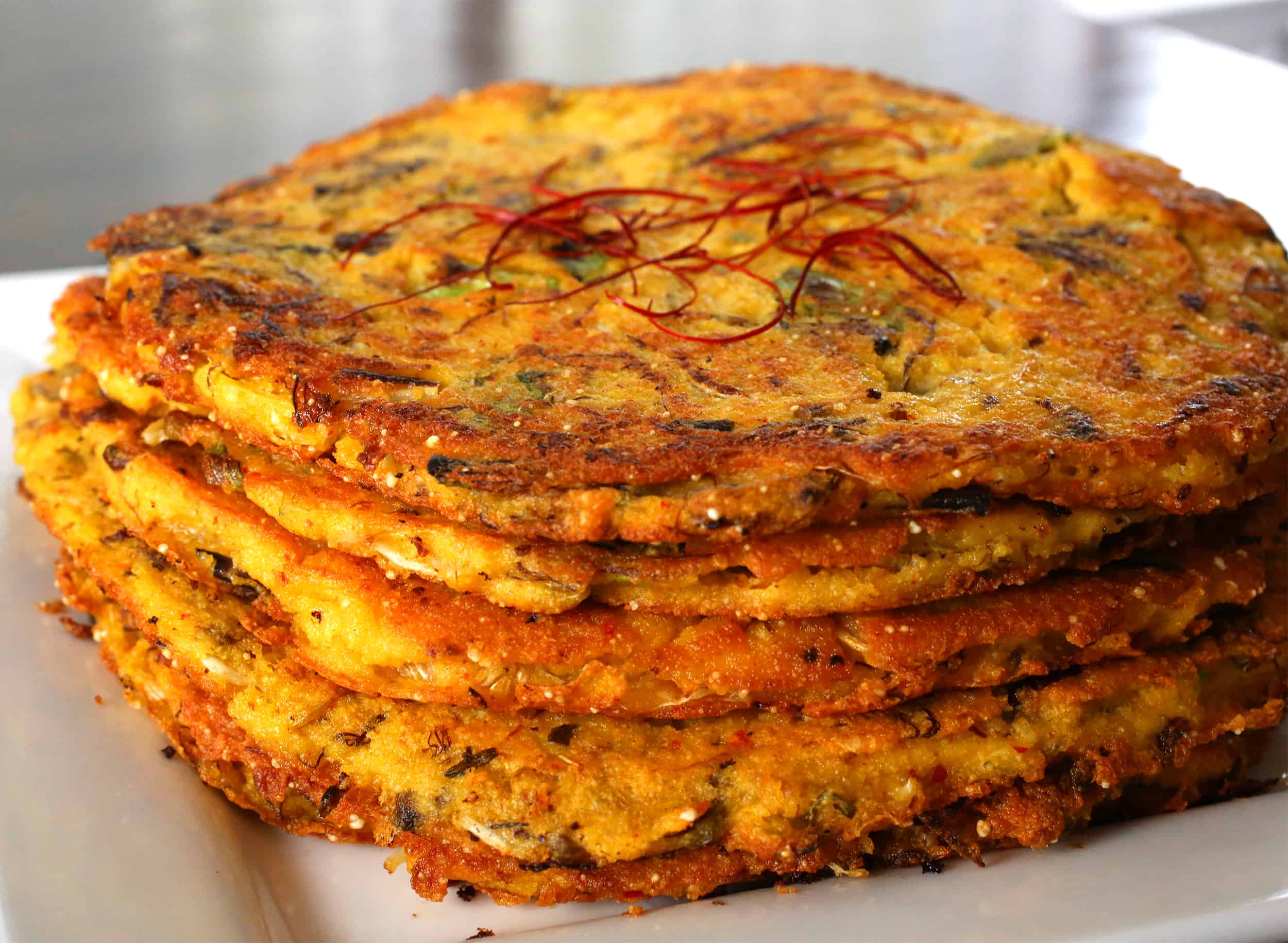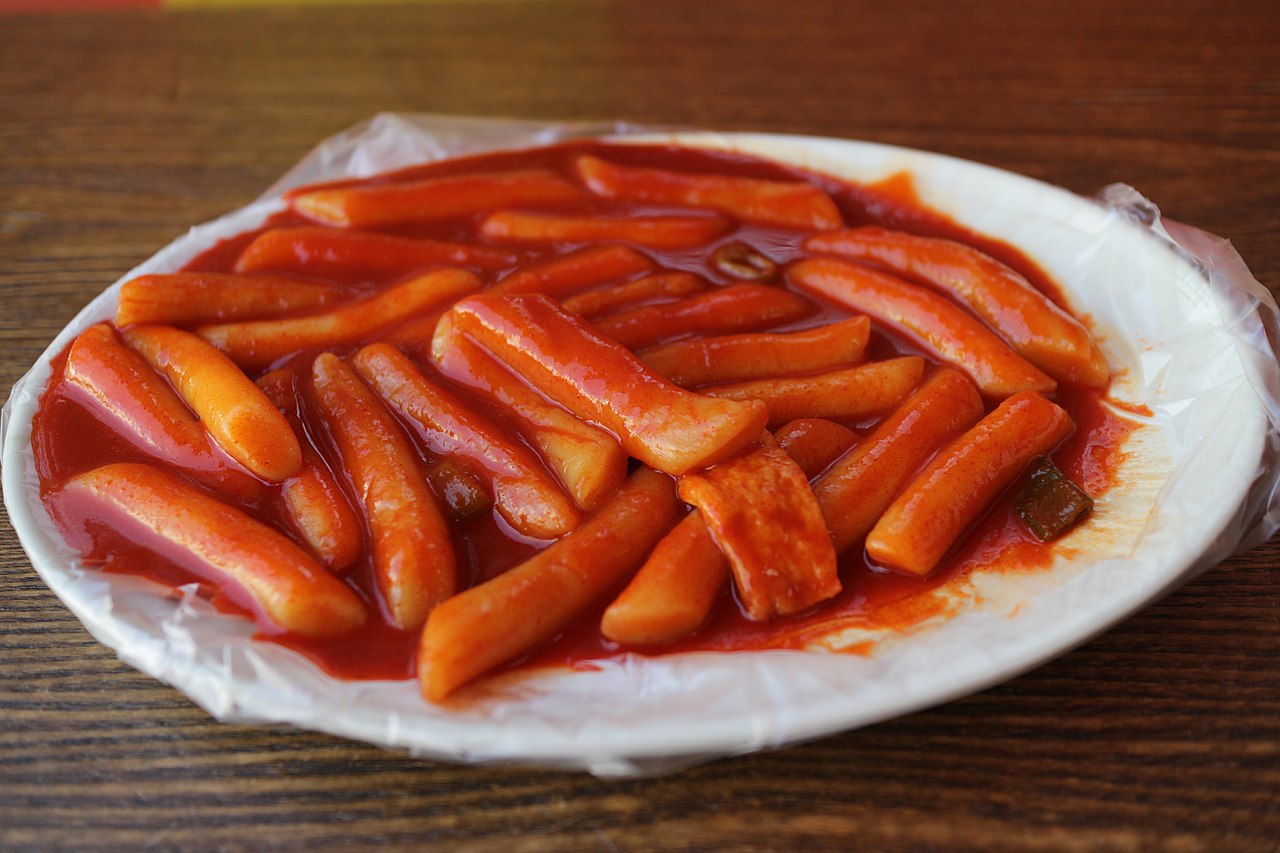Korea food
Korea food
Chili Pickled Cabbage (Kimchi 김치)
Kimchi is a famous traditional side dish made from salted
and fermented vegetables, most commonly napa cabbage and Korean radishes, with
a variety of seasonings, including gochugaru (chili powder), scallions, garlic,
ginger, and jeotgal (salted seafood). There are hundreds of varieties of kimchi
made with different vegetables as the main ingredients. In the past, kimchi was
traditionally stored underground in jars to keep cool during warm months, and
remain unfrozen throughout the winter months, during which time it was a vital
source of vegetables.
How to make kimchi in 2 minutes.
Samgyeopsal (삼겹살)
Directly translated from Korean, samgyeop-sal (삼겹살) means "three layer flesh," referring to
striations of lean meat and fat in the pork belly that appear as three layers
when cut. In Korea, the word samgyeop-sal, meaning "pork belly",
often refers to samgyeop-sal-gui (grilled pork belly), in the same way that the
word galbi, meaning "ribs", often refers to galbi-gui (grilled beef
ribs).
Pork Bulgogi (Daeji Bulgogi 불고기)
Another famous Korean specialty barbecued meat is known as
Bulgogi. While it’s normally made from beef, bulgogi can also be made
with thin strips of pork or chicken.
Before the meat is grilled, it’s marinated in sweet soy
sauce with lots of garlic and sesame oil. The version I ate above was from the
New Valley restaurant in Seoul that specializes in pork bulgogi known
as Dwaeji Bulgogi.

Korean Barbecue (Gogigui 고기구이)
Gogigui refers to the
popular method in Korean cuisine of grilling meat, typically beef, pork, or
chicken. Such dishes are often prepared on gas or charcoal grills built into
the dining table itself. Some Korean restaurants that do not have built-in
grills provide customers with portable stoves for diners to use at their
tables. Alternatively, a chef uses a centrally displayed grill to prepare
dishes to order.

Hangover Stew (Haejangguk 해장국)
Haejangguk refers to
all kinds of guk or soup eaten as a hangover cure in Korean cuisine. It means
"soup to chase a hangover" and is also called sulguk (Korean: 술국). It usually consists of dried Napa cabbage,
vegetables and meat in a hearty beef broth. One type of haejangguk, Seonjiguk,
includes sliced congealed ox blood (similar to black pudding) and another type,
Sundaeguk includes a kind of blood sausage made with intestine stuffed with
pig's blood and other ingredients.

SOFT TOFU STEW (SUNDUBU JJIGAE 순두부찌게)
A flaming hot pot of Sundubu Jjigae is a
flavorful Korean dish. Made with super soft tofu, a few bits of seafood,
addictive kimchi soup, and an egg thrown on top, there’s not much else as
comforting on a cold rainy day.
This tofu stew is best enjoyed with a side of steamed rice
and a few pickled vegetables.
Bottom of Form

Fish
Stew (Saengseon Jjigae 생선찌개)
Fish Stew is a Korean dish similar to a Western stew. There
are many varieties; it is typically made with meat, seafood or vegetables in a
broth seasoned with gochujang, doenjang, ganjang or saeujeot.Jjigae is usually
served in a communal dish and boiling hot.

Korean
Ox Bone Soup (Seolleongtang 설렁탕)
Seolleongtang is a
Korean broth tang (soup) made from ox bones (mostly leg bones), brisket and
other cuts. Seasoning is generally done at the table according to personal
taste by adding salt, ground black pepper, red pepper, minced garlic, or
chopped spring onions. It is a local dish of Seoul.

Hotpot Mixed Rice (Dolsot Bibimbap 돌솥 비빔밥)
Dolsot Bibimbap is a Korean rice dish. The term “bibim”
means mixing various ingredients, while the “bap” noun refers to rice. Bibimbap
is served as a bowl of warm white rice topped with namul (sautéed and seasoned
vegetables) and gochujang (chili pepper paste), soy sauce, or doenjang (a
fermented soybean paste). A raw or fried egg and sliced meat (usually beef) are
common additions. The hot dish is stirred together thoroughly just before
eating.

Steamed
Mandu Dumplings (Jjinmandu 찐만두)
Jjinmandu are
dumplings in Korean cuisine. Mandu can be steamed, boiled, pan-fried, or
deep-fried. The styles also vary across regions in Korean PeninsulaMandu were
long part of Korean royal court cuisine, but are now found in supermarkets,
restaurants, and snack places such as pojangmacha, bunsikjip throughout Korea.

NOODLES IN ICE SOUP (MUL NAENGMYEON 물 냉면)
Mul Naengmyeon is a Korean noodle dish of long and thin
handmade noodles made from the flour and starch of various ingredients,
including buckwheat (메밀, memil), potatoes, sweet
potatoes, arrowroot starch (darker color and chewier than buckwheat noodles),
and kudzu (칡, chik). Buckwheat predominates
(despite the name, it is not a wheat but rather is more closely related to
sorrel). Other varieties of naengmyeon are made from ingredients such as
seaweed and green tea.

KIMCHI FRIED RICE (KIMCHI BOKKEUMBAP 김치 볶음밥)
Take South Koreas most iconic vegetable garnish (kimchi),
stir fry it with a few chunks of hot dog or luncheon meat and rice, cover it
with a fried egg and sprinkle it with toasted seaweed and sesame seeds and
you’ve got a dish that no one could dislike!
It’s the type of South Korean food that tastes good any day
of the week or for whatever mood you’re in. Don’t forget to eat kimchi fried
rice with a side of kimchi!

Fried Sweet Potato Noodles (Japchae 잡채)
Japchae is a sweet
and savory dish of stir-fried glass noodles and vegetables that is popular in
Korean cuisine. Japchae is typically prepared with dangmyeon, a type of
cellophane noodles made from sweet potato starch; the noodles are topped with
assorted vegetables, meat, and mushrooms, and seasoned with soy sauce and
sesame oil

Mung Bean Pancake (Bindaetteok 빈대떡)
Bindaetteok is a type of buchimgae (Korean pancake) that originated
in the Pyongan Province. It is made by grinding soaked mung beans, adding
vegetables and meat and pan-frying it into a round, flat shape.

Korean
Blood Sausage (Soondae 순대)
Soondae is a type of blood sausage in Korean cuisine. It is a popular street food in both North and South Korea, generally made by steaming cow or pig's intestines stuffed with various ingredients.

Gimbap 김밥
Gimbap d meal, or dosirak, to be eaten at picnics and outdoor events, and can serve as a light lunc is a Korean dish made from cooked rice and other ingredients that are rolled in gim—dried sheets of nori seaweed—and served in bite-sized slices. The dish is often part of a packeh along with danmuji (yellow pickled radish) and kimchi. It is a popular take-out food in Korea and abroad, and is known as a convenient food because of its portability. It is usually well wrapped (traditionally with aluminium-foil, but now sometimes in paper) and does not have any liquid ingredients.

Korean Chicken Skewers (Dakkochi 닭꼬치)
Dak-kkochi is a popular South Korean street food consisting of small pieces of chicken and scallions grilled on a skewer.
Dak (chicken) is the most popular type of kkochi (skewered food). Others include sausages, fish cakes, and short rib patties called tteok-galbi.

Korean Side Dishes (Banchan반찬)
Banchan banchan [pan.tɕʰan]) or bansang is a collective name for small side dishes served along with cooked rice in Korean cuisine. As the Korean language does not distinguish between singular and plural grammatically, the word is used for both one such dish or all of them combined. The basic table setting for a meal called bansang (반상) usually consists of bap (밥, cooked rice), guk or tang (soup), gochujang or ganjang, jjigae, and kimchi.
Banchan are set in the middle of the table to be shared. At the center of the table is the secondary main course, such as galbi or bulgogi, and a shared pot of jjigae. Bowls of cooked rice and guk (soup) are set individually. Banchan are served in small portions, meant to be finished at each meal and are replenished during the meal if not enough. Usually, the more formal the meals are, the more banchan there will be. Jeolla province is particularly famous for serving many different varieties of banchan in a single meal.

Red Rice Cakes (Tteokbokki 떡볶이)
Tteok-bokki (떡볶이) or stir-fried rice cakes is a popular Korean food made from small-sized garae-tteok (long, white, cylinder-shaped rice cakes) called tteokmyeon (떡면; "rice cake noodles") or commonly tteok-bokki-tteok (떡볶이 떡; "tteok-bokki rice cakes"). Fish cakes, boiled eggs, and scallions are some of the most commonly added ingredients. It can be seasoned with either spicy gochujang (chili paste) or non-spicy ganjang (soy sauce)-based sauce; the former being the prototype, and the latter often called gungjung-tteok-bokki (royal court tteok-bokki). Today, variations also include curry-tteok-bokki, cream sauce-tteok-bokki, jajang-tteok-bokki, seafood-tteok-bokki, galbi-tteok-bokki and so on. Tteok-bokki is commonly purchased and eaten at bunsikjip (snack bars) as well as pojangmacha (street stalls).

Fish Cake
The most common is skewered odeng submerged in warm,
flavorful broth. Something similar but definitely much more filling and potent:
served in broth with chopped chilies, green onions, and seasoned with gochujang
–a cure for colds and hangovers. Deep-fried odeng is also a tasty find,
especially when served with a mustard-ketchup sauce.

Introduce about fish cake
5 famous Korean Food



Good
ReplyDeleteI like this Blogger.
ReplyDeleteVery good details of Korean food. Thanks for sharing.
ReplyDelete